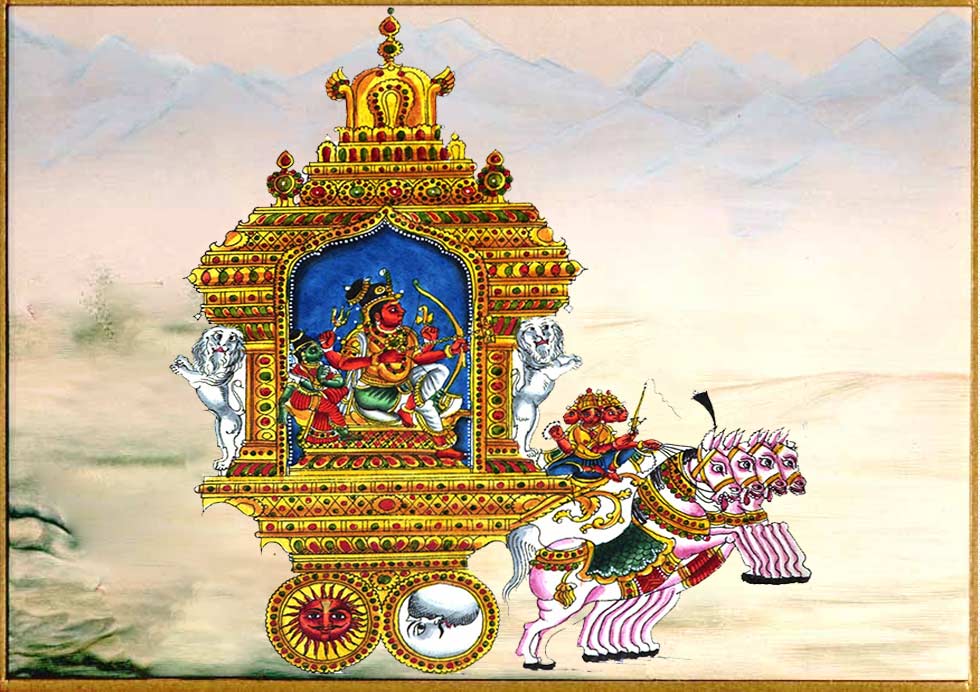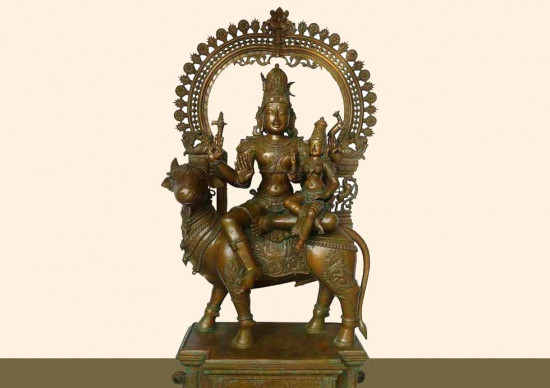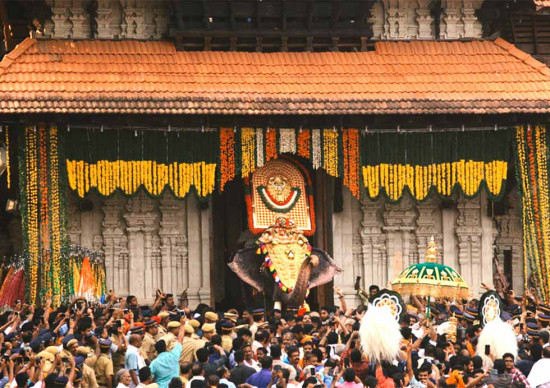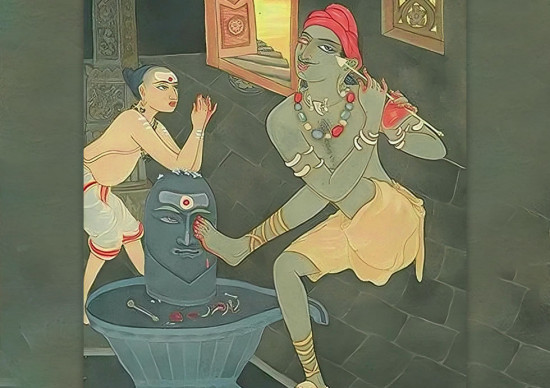In the rich tapestry of Hindu mythology, the iconography of Tripurantaka Shiva stands as a profound representation of the cosmic order. Also known as Tripurasura Samhara, this revered form of Lord Shiva assumes the role of the destroyer of the three cities, a narrative that resonates deeply in the artistic expressions of India. Whether captured in vibrant paintings or immortalized in statues, the depiction of Shiva as Tripurasura Samharam is a ubiquitous motif across the diverse artistic landscape of the country. This divine manifestation of Shiva as the annihilator of the three cities encapsulates a potent symbolism, symbolizing the triumph of cosmic balance over chaos.
Iconography of Chatura Tandva Shiva
In this iconography, Tripurantaka Shiva, presents as a handsome youth with robust limbs and a serene smile. His hair is fashioned into a crown adorned with jewels known as Jatamukuta and Datura flowers. The Tripurasura Samhara Murti dons male and female earrings in the right and left ears, respectively, symbolizing completeness. The sculpture is elevated on an exquisite, sturdy lotus base.
Tripurantaka Shiva is commonly portrayed with four arms, wielding a trishula in the third (right) and a damaru in the fourth (left). The remaining two arms clasp the Pinaka bow, releasing the formidable Pashupatastra missile directed at Tripura. This portrayal traces back to the 6-7 AD period in Pattadakal, during the Badami Chalukya era, with the Rashtrakutas continuing this representation at sites like Ellora and Kailasanatha Temple.
Tripurantaka Shiva is commonly portrayed with four arms, wielding a trishula in the third (right) and a damaru in the fourth (left). The remaining two arms clasp the Pinaka bow, releasing the formidable Pashupatastra missile directed at Tripura. This portrayal traces back to the 6-7 AD period in Pattadakal, during the Badami Chalukya era, with the Rashtrakutas continuing this representation at sites like Ellora and Kailasanatha Temple.
The Kalyana Chalukyas further enriched Tripurantaka’s depiction in the Tripuranthakeshwara temple at Balligave. The Hoysala period saw a nuanced evolution of this narrative, embellished with intricate ornamentation, notably seen in temples at Javagal and Hosa Holalu. During this era, the representation introduced the depiction of Tripurasura in three circular patterns, a stylistic legacy upheld by Vijayanagara sculptors and painters. This detailed portrayal is observable in the murals at the Virupaksha temple in Hampi.
In the realm of Hindu art, Tripurantaka emerges as a monumental figure radiating light into darkness, symbolizing the “destroyer of evil and darkness.” This divine imagery, encapsulated across various historical periods and regions, underscores the enduring significance of Tripurantaka as a symbol of cosmic balance and the triumph of light over darkness.
In the realm of Hindu art, Tripurantaka emerges as a monumental figure radiating light into darkness, symbolizing the “destroyer of evil and darkness.” This divine imagery, encapsulated across various historical periods and regions, underscores the enduring significance of Tripurantaka as a symbol of cosmic balance and the triumph of light over darkness.
The Divine Tale Of Shiva Destroying The Three Cities

Once upon a time, there was a demon named Tarakasura who caused a lot of trouble for everyone on Earth and for divine realms. In the end, Lord Kartikeya defeated and killed him. Tarakasura had three sons named Tarakaksha, Kamalaksha (also known as Virayavana), and Vidyunmali. These sons wanted to become immortal, so they performed intense penance to please Lord Brahma. When Lord Brahma appeared and asked what they desired for their unwavering devotion, they requested immortality. However, realizing the consequences, Lord Brahma offered them an alternative.
The demon brothers then asked for three cities made of gold, silver, and iron, revolving around the galaxies. They also wanted a special condition – they could only be killed when the three cities aligned in one axis for a fraction of a second, once every 1000 years, and only by a single arrow. Lord Brahma granted their request and instructed the demon architect Mayasura to build these extraordinary cities.
Living in their respective cities with their Asur citizens, the demon brothers seemed content. However, the gods became worried, fearing that these demons might cause destruction similar to Tarakasura. When they approached Lord Brahma and later Lord Shiva to intervene, both refused, stating that the demons were not doing anything wrong.
The demon brothers then asked for three cities made of gold, silver, and iron, revolving around the galaxies. They also wanted a special condition – they could only be killed when the three cities aligned in one axis for a fraction of a second, once every 1000 years, and only by a single arrow. Lord Brahma granted their request and instructed the demon architect Mayasura to build these extraordinary cities.
Living in their respective cities with their Asur citizens, the demon brothers seemed content. However, the gods became worried, fearing that these demons might cause destruction similar to Tarakasura. When they approached Lord Brahma and later Lord Shiva to intervene, both refused, stating that the demons were not doing anything wrong.
Disappointed, the gods turned to Lord Vishnu for help. He advised them that since the demons were not causing harm, the solution was to influence them to do something bad. Thus, a new chapter unfolded in their quest to maintain cosmic balance.
Lord Vishnu then created a man. This man’s head was shaven, his clothes were faded and he carried a wooden water-pot in his hands. He approached Vishnu. “What are my orders?” he asked Vishnu.
Lord Vishnu created a man with a shaved head, who is wearing faded clothes, and holds a wooden water-pot. When the man asked for his orders, Lord Vishnu explained that he was meant to learn and spread a religion opposing the Vedas. This religion would reject the idea of heaven and hell, believing both to be on earth. The man was to go to Tripura and teach this religion to the demons, leading them away from the righteous path.
Following Vishnu’s instructions, the man and his four disciples went to a forest near Tripura to preach. Trained by Vishnu, their teachings were convincing, attracting many converts. Even the sage Narada became confused and converted. Narada then informed King Vidyunmali about this new religion, claiming it to be wonderful and different from anything he had heard before.
After the sage Narada was converted, Vidyunmali, Tarakaksha, and Kamalaksha followed suit, embracing the new religion. They turned away from the Vedas and stopped worshiping Shiva linga. Concerned about their actions, the gods approached Shiva and prayed for his intervention, revealing that the asuras had turned evil and abandoned their reverence for Shiva’s linga.
Shiva, agreeing to the gods’ request, decided to destroy Tripura. Vishvakarma, the gods’ architect, was tasked with creating a chariot, bow, and arrow for this purpose. The chariot, entirely crafted from gold, had Brahma as its charioteer. And Sun and Moon become the wheels of the chariot. As the asuras can only be killed by a single arrow shiva, the dand of the arrow was Mount meru, and the Pratyancha (string) was Vasuki himself and Lord Vishnu as arrow.
With diverse weapons in hand, Shiva, accompanied by the gods, swiftly headed towards Tripura to restore balance and righteousness.
As Shiva’s army approached the battlefield, the three forts were on the verge of merging into a single entity, Tripura, a fleeting moment lasting only a second. Seizing this precise instant, Lord Shiva unleashed the formidable Pashupatastra, the most destructive weapon under His control. With unparalleled precision, Shiva’s arrow struck the merged forts, reducing the asuras’ strongholds to ashes. This decisive act earned Shiva the titles of Tripurantaka, the vanquisher of Tripura, and Paśupatinath, the wielder of the Pashupatastra. He also became known as Tripurari.
An alternate version, prominently found in Tamil literature, depicts Shiva destroying Tripura with a mere smile. Amidst the warriors, with Brahma and Vishnu witnessing the battlefield, the moment arrived when the forts converged. Shiva, with a simple smile, turned the forts into ashes, concluding the battle before it truly began. In Tamil tradition, Shiva is hailed as “Sirithu Purameritha Peruman,” signifying the one who incinerated the cities with a mere smile.
As celebrations ensued, the shaven-headed religious teachers sought guidance on their next steps. Brahma and Vishnu instructed them to retreat to a deserted place without human presence. They were to await the arrival of Kali Yuga, the last of the four eras, where evil would dominate. Upon the onset of Kali Yuga, they were to return, resuming their teachings. However, it was foretold that when they reached their pinnacle, a divine reincarnation would emerge, eliminating them and restoring the world to freedom from all forms of evil and asuras.
Lord Vishnu then created a man. This man’s head was shaven, his clothes were faded and he carried a wooden water-pot in his hands. He approached Vishnu. “What are my orders?” he asked Vishnu.
Lord Vishnu created a man with a shaved head, who is wearing faded clothes, and holds a wooden water-pot. When the man asked for his orders, Lord Vishnu explained that he was meant to learn and spread a religion opposing the Vedas. This religion would reject the idea of heaven and hell, believing both to be on earth. The man was to go to Tripura and teach this religion to the demons, leading them away from the righteous path.
Following Vishnu’s instructions, the man and his four disciples went to a forest near Tripura to preach. Trained by Vishnu, their teachings were convincing, attracting many converts. Even the sage Narada became confused and converted. Narada then informed King Vidyunmali about this new religion, claiming it to be wonderful and different from anything he had heard before.
After the sage Narada was converted, Vidyunmali, Tarakaksha, and Kamalaksha followed suit, embracing the new religion. They turned away from the Vedas and stopped worshiping Shiva linga. Concerned about their actions, the gods approached Shiva and prayed for his intervention, revealing that the asuras had turned evil and abandoned their reverence for Shiva’s linga.
Shiva, agreeing to the gods’ request, decided to destroy Tripura. Vishvakarma, the gods’ architect, was tasked with creating a chariot, bow, and arrow for this purpose. The chariot, entirely crafted from gold, had Brahma as its charioteer. And Sun and Moon become the wheels of the chariot. As the asuras can only be killed by a single arrow shiva, the dand of the arrow was Mount meru, and the Pratyancha (string) was Vasuki himself and Lord Vishnu as arrow.
With diverse weapons in hand, Shiva, accompanied by the gods, swiftly headed towards Tripura to restore balance and righteousness.
As Shiva’s army approached the battlefield, the three forts were on the verge of merging into a single entity, Tripura, a fleeting moment lasting only a second. Seizing this precise instant, Lord Shiva unleashed the formidable Pashupatastra, the most destructive weapon under His control. With unparalleled precision, Shiva’s arrow struck the merged forts, reducing the asuras’ strongholds to ashes. This decisive act earned Shiva the titles of Tripurantaka, the vanquisher of Tripura, and Paśupatinath, the wielder of the Pashupatastra. He also became known as Tripurari.
An alternate version, prominently found in Tamil literature, depicts Shiva destroying Tripura with a mere smile. Amidst the warriors, with Brahma and Vishnu witnessing the battlefield, the moment arrived when the forts converged. Shiva, with a simple smile, turned the forts into ashes, concluding the battle before it truly began. In Tamil tradition, Shiva is hailed as “Sirithu Purameritha Peruman,” signifying the one who incinerated the cities with a mere smile.
As celebrations ensued, the shaven-headed religious teachers sought guidance on their next steps. Brahma and Vishnu instructed them to retreat to a deserted place without human presence. They were to await the arrival of Kali Yuga, the last of the four eras, where evil would dominate. Upon the onset of Kali Yuga, they were to return, resuming their teachings. However, it was foretold that when they reached their pinnacle, a divine reincarnation would emerge, eliminating them and restoring the world to freedom from all forms of evil and asuras.







